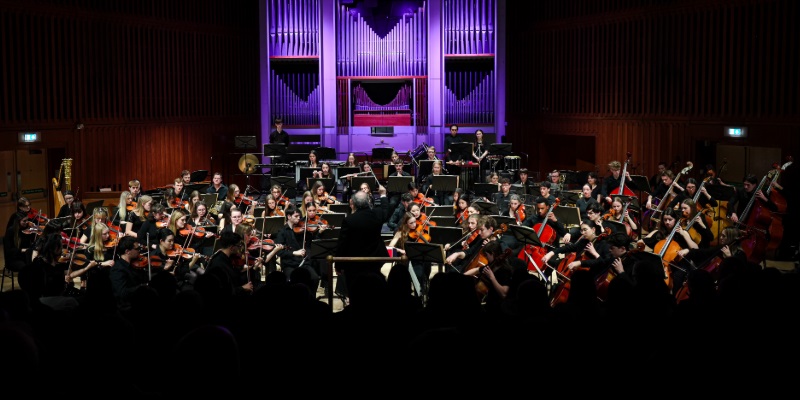
THIS excellent York Concerts series continued with a really attractive programme of Mendelssohn, Busoni and Richard Strauss.
It opened with Mel Bonis’s Le Songe de Cléopâtre, op. 180. To be honest, the only thing I knew about the composer was that her actual name was Mélanie, publishing her works under the gender-neutral name of Mel Bonis in an attempt to avoid the inevitable prejudice against women composers.
But the performance of this wonderful crafted miniature clearly revealed a composer of real stature and individuality. As the title implies, the work is inspired by the influential Egyptian queen, Cleopatra. And there did seem to be a programmatic element, a response to the strong, seductive qualities associated with this historic femme fatale.
I could clearly hear the impressionistic influence of Debussy, although the rich orchestral swells suggested the music of Wagner. Maybe. The string tuning was not always on the money (the auditorium was pretty warm), but lovely flute and clarinet playing stood out and the overall performance convinced.
Taking centre stage for Mendelssohn’s Piano Concerto no. 1 in G minor, op. 25 was third-year university music student Alexa MacLaren. Not surprisingly, there were some early signs of nerves but the introduction was nevertheless simply exhilarating.
I loved the overall charm of the playing, the sparkling passagework dispensing with the unnecessary dramatic showmanship. Attention to detail was ever present. The playful nature of the Presto finale was instinctively captured by Ms MacLaren, as in the rhythmically crisp articulation – far from easy at this very lively tempo and sparkling scale passages.
But it was the lyrical passages, the singing melodies, particularly in the tonally radiant E major Andante, which stayed with me. The phrasing, expression and avoidance of sentimentality worked beautifully. The rapturous response from the capacity audience was genuinely touching.
Ferruccio Busoni is a towering figure in ‘modern’ music. His music breathes the contrapuntal sound world of J S Bach – the great Fantasia Contrappuntistica on an unfinished fugue by Bach is a remarkable homage to the great man, just as much as it breathes the “air from another planet”.
Busoni was a friend of Arnold Schoenberg. He also had a close relationship, both personally and professionally, with Gustav Mahler. And it was Mahler and the New York Philharmonic who gave the first performance of Busoni’s short Berceuse élégiaque for orchestra, op.42 in 1911.
The Berceuse is an atmospheric, contemplative work and John Stringer’s insightful reading allowed it the space to gradually unfold. I was struck by the subtlety of the instrumental timbres and gently jarring (major and minor) tonalities and harmonic patterns.
The performance created a dream-like world, drifting through a quite unique musical landscape. The dark, elegiac intimacy surely was a response to the death of his mother. Indeed, the score itself is headed by the enigmatic words “A man’s cradle-song at his mother’s bier”. A bier is the stand on which a corpse or coffin is placed (I had to look this one up).
A slight whinge before turning to the Strauss: the slightly surreal amplified call to refrain from taking photos is a good thing, but then having a photographer taking shots from the rear of the auditorium with a camera the size of a mini Hubble telescope ain’t – it’s distracting.
So, from one master of atmospheric orchestration and colour to another, Richard Strauss’s tone poem Tod und Verklärung (Death and Transfiguration). The musical narrative depicts the death of an artist.
As the man lies on his death bed, thoughts of his life pass through his head: his childhood innocence, the struggles of his manhood, the attainment of his earthly goals and finally the mother of all transfigurations “from the infinite reaches of heaven”. A bit like Elgar’s Dream Of Gerontius composed 11 years later – both 19th-century Europeans and Victorians were obsessed with death and mysticism.
The work opens with quiet pulsing strings and timpani suggesting life, the living, but its irregularity of beat suggests a slowly failing heartbeat and the imminence of death. John Stringer’s orchestral instincts were well served here, generating a quiet, unsettling musical moment of unwanted familiarity. There were telling flute, oboe and string contributions.
The second movement was absorbing, with the heartbeat theme threading the musical narrative together, culminating in a brilliant full orchestral manifestation with the brass (trumpets and trombones) articulating a new idea. The ending was quiet and bleak.
I found the third movement really engaging as the dying man’s life is played out: aims, aspirations and failure to achieve them. The performance became appropriately agitated, tormented and explosive.
The moment of death and transfiguration was effectively evoked; a climax of dramatic glissando strings followed to an eerie, unearthly quiet gong calls and a low sustained C in the bowels of the orchestra itself.
The transfiguration begins with the whole orchestra pianissimo, fine horn and (celestial, what else?) harp playing leading to the “true and ultimate heavenly paradise”.
Another really fine outing for the University Symphony Orchestra, admirably directed once again by John Stringer. On a personal note, I hope to see the day when Mr Stringer decides to include some of his own impressive compositions into these programmes.
But the final word belongs with final-year student Alexa MacLaren; an exceptional young pianist at the start of a clearly promising career. We wish her well.
Review by Steve Crowther
